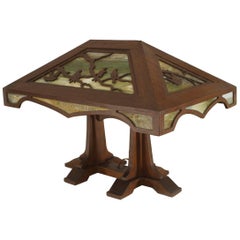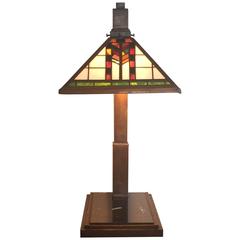Mission Style Desk Lamp
Early 20th Century American Mission Table Lamps
Glass, Oak
Recent Sales
Late 20th Century American Mission Table Lamps
Marble, Copper
People Also Browsed
Vintage 1970s English Mid-Century Modern Sterling Silver
Sterling Silver
Vintage 1920s French Art Deco Chandeliers and Pendants
Wrought Iron
Vintage 1960s American Ottomans and Poufs
Copper
Antique Late 19th Century Italian Arts and Crafts Floor Mirrors and Full...
Marble
Early 20th Century American Art Nouveau Table Lamps
Metal
Antique Early 1900s English Arts and Crafts Tray Tables
Copper
Early 20th Century Dutch Arts and Crafts Religious Items
Copper, Brass
Vintage 1960s Danish Scandinavian Modern Chairs
Rosewood
Vintage 1930s American Art Deco Cabinets
Onyx, Brass, Bronze, Iron
Early 20th Century American Mission Sideboards
Oak
Vintage 1930s French Art Deco Table Lamps
Bronze, Wrought Iron
Vintage 1930s American Art Deco Dry Bars
Bronze
Early 20th Century American Arts and Crafts Daybeds
Leather, Oak
Antique Late 19th Century American Japonisme Sterling Silver
Sterling Silver
Vintage 1980s American Tables
Bronze
20th Century Unknown Art Nouveau Floor Lamps
Wrought Iron
Mission Style Desk Lamp For Sale on 1stDibs
How Much is a Mission Style Desk Lamp?
Finding the Right Table-lamps for You
Well-crafted antique and vintage table lamps do more than provide light; the right fixture-and-table combination can add a focal point or creative element to any interior.
Proper table lamps have long been used for lighting our most intimate spaces. Perfect for lighting your nightstand or reading nook, table lamps play an integral role in styling an inviting room. In the years before electricity, lamps used oil. Today, a rewired 19th-century vintage lamp can still provide a touch of elegance for a study.
After industrial milestones such as mass production took hold in the Victorian era, various design movements sought to bring craftsmanship and innovation back to this indispensable household item. Lighting designers affiliated with Art Deco, which originated in the glamorous roaring ’20s, sought to celebrate modern life by fusing modern metals with dark woods and dazzling colors in the fixtures of the era. The geometric shapes and gilded details of vintage Art Deco table lamps provide an air of luxury and sophistication that never goes out of style.
After launching in 1934, Anglepoise lamps soon became a favorite among modernist architects and designers, who interpreted the fixture as “a machine for lighting,” just as Le Corbusier had reimagined the house as “a machine for living in.” The popular task light owed to a collaboration between a vehicle-suspension engineer by the name of George Carwardine and a West Midlands springs manufacturer, Herbert Terry & Sons.
Some mid-century modern table lamps, particularly those created by the likes of Joe Colombo and the legendary lighting artisans at Fontana Arte, bear all the provocative hallmarks associated with Space Age design. Sculptural and versatile, the Louis Poulsen table lamps of that period were revolutionary for their time and still seem innovative today.
If you are looking for something more contemporary, industrial table lamps are demonstrative of a newly chic style that isn’t afraid to pay homage to the past. They look particularly at home in any rustic loft space amid exposed brick and steel beams.
Before you buy a desk lamp or table lamp for your living room, consider your lighting needs. The Snoopy lamp, designed in 1967, or any other “banker’s lamp” (shorthand for the Emeralite desk lamps patented by H.G. McFaddin and Company), provides light at a downward angle that is perfect for writing, while the Fontana table lamp and the beloved Grasshopper lamp by Greta Magnusson-Grossman each yield a soft and even glow. Some table lamps require lampshades to be bought separately.
Whether it’s a classic antique Tiffany table lamp, a Murano glass table lamp or even a bold avant-garde fixture custom-made by a contemporary design firm, the right table lamp can completely transform a room. Find the right one for you on 1stDibs.

